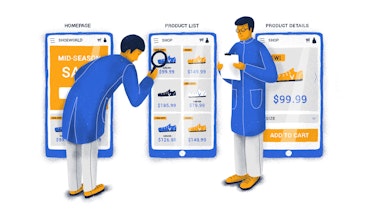No matter what you’re selling, chances are high that someone else is offering a similar — possibly even the same — product or service.
So, how can you effectively deal with your competitors and gain an edge over them?
The answer is competitive analysis.
Learn how to empower your company through a competitive analysis and set your product up for success.
What Is a Competitive Analysis and What Is Its Purpose?
A competitive analysis is a strategic tactic used to identify and evaluate competitors. The purpose of a competitor analysis is to determine the competitor’s strengths and weaknesses relative to your own product.
The main objectives of a competitive analysis are to:
Study the market scenery.
Predict market demand and supply.
Reformulate your business strategy.
Forecast market trends and patterns.
Recognize opportunities.
Acknowledge threats.
Calculate your competitor’s next move.
Redefine your company objectives.
“If all you're trying to do is essentially the same thing as your rivals, then it's unlikely that you'll be very successful.”
— Michael Porter
By learning what your competitors are doing and how they are doing it, you can take necessary measures to improve your company’s performance and differentiate yourself from rival companies.
How Do You Conduct a Competitive Analysis?
1. Create a List of Your Competitors
The first step is to identify your competitors. Now, you might think this is an easy feat, but it’s actually quite complex.
Sure, you might know one or two companies that you consider competition, but this is not enough to complete a competitive analysis.
Try to find at least 10 competitors with the help of:
Search engines. Simply running your company name in a search engine will automatically generate suggestions of businesses that offer the same or a similar product.
Search engine ads. Similar to search engine suggestions, search engine ads show paid ads from companies who are targeting the same market as you.
Prospects and customers. Learn about your competitors directly from the source. Ask your prospects and customers about any other businesses they’ve come by or used in the past.
Social media channels and forums. Look out for any mentions of competitors on social media and people discussing their products or services on discussion boards.
After you find at least 10 competitors, categorize them into two groups:
Direct, or primary, competitors. These are the companies that offer the same product or service as you, in the same location, and target the same audience.
For example, let’s say you sell bread. Any other bakery that also sells bread — in the same location, to the same consumer group, and at a similar price — is a direct competitor.
Indirect, or secondary, competitors. These are the companies that offer a different product or service but target the same audience and solve the same problem differently.
Using the example above, an indirect competitor would be another bakery that sells pies, cinnamon rolls, and cakes, as opposed to just bread. Though the products are different, the purpose and target audience is the same
Both types of competitors are equally important for successfully carrying out your competitive analysis.
2. Create Criteria for Comparison
The next step is creating criteria for comparison. What is it that you want to compare? Here are features you should focus on in the analysis:
Price. What pricing structures do competitors have in place?
Quality. What do users have to say about the quality of the product or service?
Customer service. How do they build and maintain relationships with customers?
Hours of operation. When are they up and running for business?
Employees. How many employees do they have?
Resources. What resources do they offer customers for a better experience?
Marketing. What does their marketing strategy look like?
Usability. Do they have a functional and practical UX design?
Design. Does the company website have a clear, intuitive design?
Sales. How much profit do they generate on a monthly/quarterly/yearly basis?
Elaborate on any or all of these variables when creating your criteria for comparison.
3. Select a Competitive Analysis Framework
One competitive analysis framework that’s an absolute hit among successful companies is a SWOT analysis. Basically, SWOT looks at four different sets of data about your competitors:
Strengths. What do your competitors do really well that differentiates them?
Weaknesses. What do customers complain about the most, and what products do they lack?
Opportunities. Have your competitors made any changes to their product that you can utilize?
Threats. Have your competitors made any changes that could have a negative impact on you?
To make the most of this competitive analysis tool, you need to collect enough data to satisfy all four areas. When you do, you can start brainstorming ideas to improve your current business practices.
4. Analyze Your Competitors
Once you’ve found your main competitors, set your criteria, and chosen your competitive analysis framework, you can finally begin running your competitive analysis.
Analyze each competitor against your list of criteria, and answer all the questions relevant to refining your company processes. Use the SWOT tool to create a template that will ensure that you stay on track and organize your data accordingly.
When you’ve gathered enough information about your competitors, put all the data together and see exactly where your company stands in comparison to competitors.
5. Identify Areas for Improvement
At first, you might find your findings a bit overwhelming. This is okay. Things will be much clearer once you start sorting through the data. Categorize your findings in a way that is easy for you to reference, such as by competitor or feature.
“Becoming number one is easier than remaining number one.”
— Bill Bradley
Take all the information and identify areas for improvement. Namely, what changes can you make or what innovations can you introduce to improve your company?
Perhaps you can redesign your landing pages, change your pricing structure, or look for ways to polish up your customer experience?
Don’t be afraid to challenge yourself and ask crucial questions that will help you make better decisions for your company.
The Bottom Line

Competitive analysis is not a one-time thing. It’s an ongoing process. New competitors can appear without notice, old rivals can disappear at once, and the market demand can shift at any time.
When it comes to competitive analysis, don’t just analyze your competitors. Analyze your own brand regularly too. Accept your weaknesses, embrace your strengths, and take advantage of incoming opportunities.
Empower your company with the help of a competitive analysis, and take your product to new heights.
What is a Competitive Analysis?
A competitive analysis is a strategic tactic used to identify and evaluate competitors.
What is the purpose of a Competitive Analysis?
The purpose of a competitive analysis is to determine the competitor’s strengths and weaknesses relative to your own product.




